| Pages:
1
..
56
57
58
59
60
..
66 |
blogfast25
International Hazard
    
Posts: 10562
Registered: 3-2-2008
Location: Neverland
Member Is Offline
Mood: No Mood
|
|
Quote: Originally posted by BobD1001  | I plan to reuse the reaction solvent, given that it works for multiple reactions, as the Tetralin was quite expensive.
|
Data on reuse/recovery of solvent/catalyst would be enormously useful.
|
|
|
Squall181
Harmless

Posts: 46
Registered: 21-2-2011
Member Is Offline
Mood: No Mood
|
|
I have been following this thread from the begging and have been wanting to give a go at this reaction ever since. Well, I finally got all of the
reagents together and today I have become the newest member to grow balls of potassium. 
After 3 weekends and about 8 different runs I was getting pretty disheartened, but with patience and perseverance I was able to get those balls.
Here is a picture of the reagents I used.
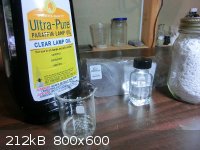
The beaker contains the larger potassium balls that I was able to pick out with tweezers.
I made magnesium fillings by taking a rasp to the Mg ingot seen in the picture.
The KOH was used as is, in flake form
The recipe was 2 grams of Mg, 5 grams of KOH, 1ml of T-butanol, 30 ml of paraffin oil. All this was added in the begging in the so called one-pot
method.
Potassium balls were seen in the reaction mixture about 30min after the temperature of the sand bath reached 220 C. The 50 ml flask was swirled about
every 20 - 30 minutes.
The collected balls were coalesced under heavier paraffin oil (Carolina science supply) into one large sphere. Pictured below. The fines were used to
create a nice pyrotechnical show.
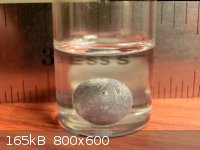
I would like to thank everyone who has contributed to this thread, this is an awesome synthesis that requires much patience.
|
|
|
BobD1001
Hazard to Others
  
Posts: 182
Registered: 29-3-2013
Member Is Offline
Mood: No Mood
|
|
My first very successful reaction!
Thats an incredible job Squall! Congrats on the successful reaction, and kudos to not giving up!
I also performed another run today, utilizing tetralin as the solvent. It was by far my most successful reaction to date, producing quite a bit of
potassium! But oh boy does the Tetralin smell! Just like naphthalene moth balls (kind of a DUH! statement there...) which is now on my sh*t list of
smells. Really got sickening when cleaning up my glassware. Anyways, here are the photos of the reaction:
A color change of my solvent was noted nearly as soon as it heated up. this eventually dissipated.
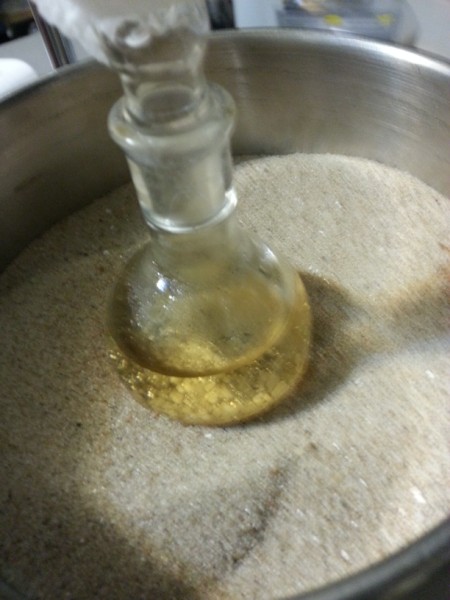
Soon after, extremely tiny potassium globules could be seen all over the surface of the Mg turnings. Its not very visible in this picture, but I am
including it for completeness.
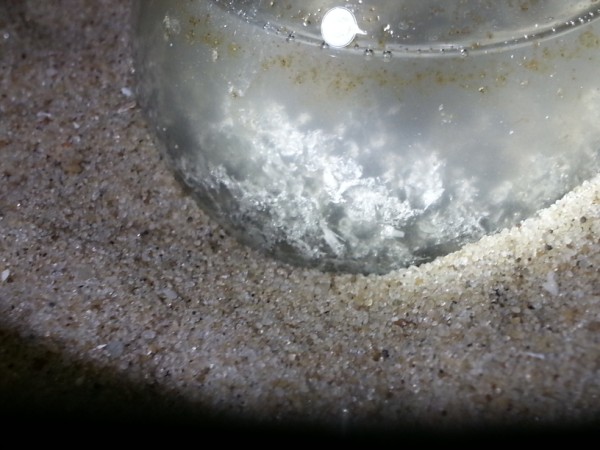
After some time, there were some large balls of potassium forming, however, they were refusing to float as they should have (i believe it may have
been oxides weighing the globules down)
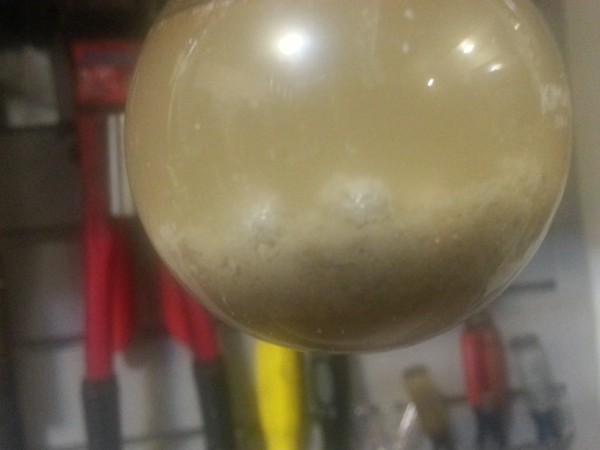
Soon after the first 'floaters' appeared:
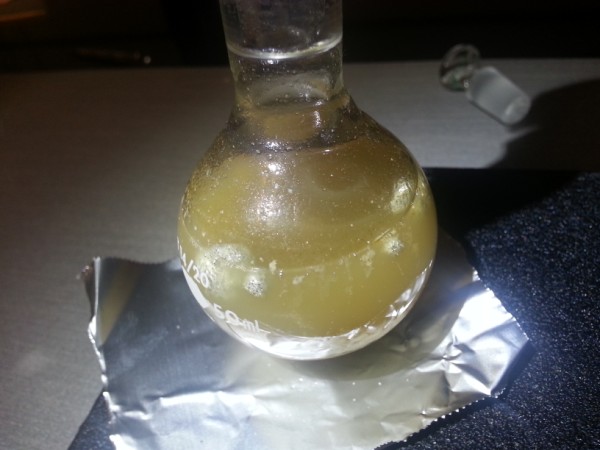
And finally, the end results!
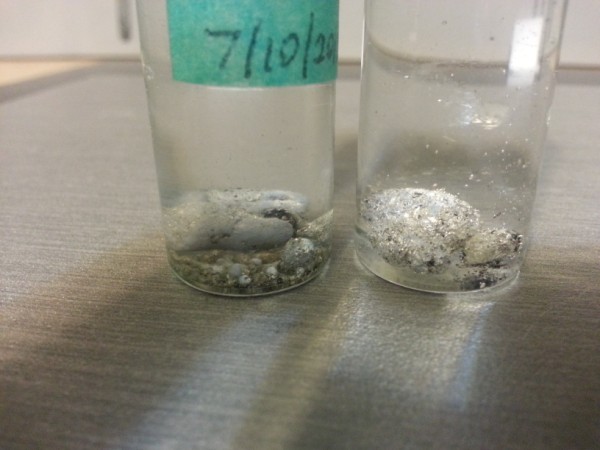
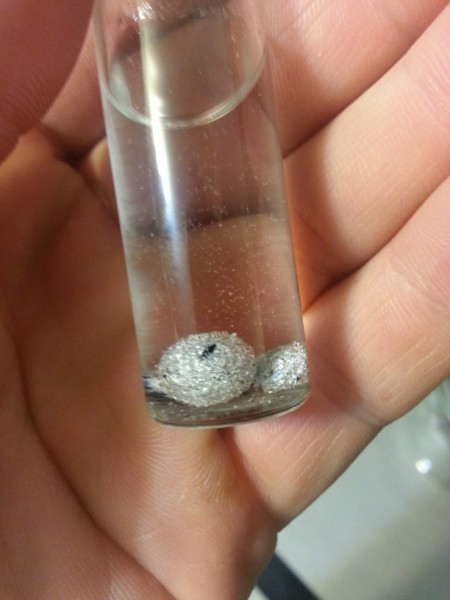
|
|
|
blogfast25
International Hazard
    
Posts: 10562
Registered: 3-2-2008
Location: Neverland
Member Is Offline
Mood: No Mood
|
|
Well, congratulations to both Squall and Bob.
Bob's experience with Tetralin is not hugely encouraging though, considering the cost (and poor availability) of this solvent. Clearly the K is being
weighed down by adhering cruds, inhibiting floating somewhat. This is somewhat different from Nurdrage's experience but IIRW he did use slow stirring.
Floating K would not only 'free up' space for new embryonic K balls to form, the floating K in the absence of cruds should coalesce much more easily.
Bob's experience doesn't seem to unambiguously bear that out.
Bob, will you now try and recover the solvent + catalyst for a second run?
Additional point: so far, at least as far as I can remember, everyone has used flaked KOH (that's me included). I wonder if a ground form of these
flakes (they grind fairly easily in a mortar and pestle - my experience in other pursuits) could provide some advantage. The way the slag (MgO) forms
does seem to have some bearing on the coalescence of the K metal, although it is difficult to describe the relationship in anything but the crudest
qualitative terms. And the physical form of the KOH may have some bearing on the physical form of the slag.
[Edited on 4-8-2013 by blogfast25]
|
|
|
Sublimatus
Hazard to Others
  
Posts: 108
Registered: 8-6-2011
Member Is Offline
Mood: No Mood
|
|
If anyone does grind their flakes, wet it with a bit of the oil you intend to use first.
I ground mine for most of my attempts at this reaction (all failures), and the first time learned how easily the dry dust can get into the air and
sting your respiratory tract. It wasn't a medical emergency, but it also wasn't pleasant.
|
|
|
bfesser
Resident Wikipedian
    
Posts: 2114
Registered: 29-1-2008
Member Is Offline
Mood: No Mood
|
|
I love seeing all of the successful preparations that are reported in this thread. It's so nice to see.
Sublimatus, I posted a <a href="viewthread.php?tid=3546#pid118075">suggestion</a> for grinding irratating powders some
years ago, if it's of any help. You may even consider flooding the bag with dry nitrogen.
[Edited on 4.8.13 by bfesser]
|
|
|
Sublimatus
Hazard to Others
  
Posts: 108
Registered: 8-6-2011
Member Is Offline
Mood: No Mood
|
|
That's an interesting solution, thanks for writing it up.
In this case I simply wetted the KOH beads with the reaction solvent they were going to end up in anyway and ground them (things are a pain to grind,
they bounce around like the silica beads you mention). It kept the caustic dust out of the air (and my lungs), and I would think kept some of the
atmospheric water out that would've accumulated in it otherwise.
|
|
|
blogfast25
International Hazard
    
Posts: 10562
Registered: 3-2-2008
Location: Neverland
Member Is Offline
Mood: No Mood
|
|
Agreed but despite the extreme length of this thread we are still sorely lacking in knowledge in the following areas:
• Use of other 2-methyl-2-ols
• Influence of type of magnesium
• Influence of stirring/occasionally swirling
• Re-using of post reaction solvent/catalyst mix
• Other, more efficient ways of coalescing K metal droplets
I hope one day we will get to the bottom of most of these issues.
|
|
|
BobD1001
Hazard to Others
  
Posts: 182
Registered: 29-3-2013
Member Is Offline
Mood: No Mood
|
|
Quote: Originally posted by blogfast25  |
Bob, will you now try and recover the solvent + catalyst for a second run?
Additional point: so far, at least as far as I can remember, everyone has used flaked KOH (that's me included). I wonder if a ground form of these
flakes (they grind fairly easily in a mortar and pestle - my experience in other pursuits) could provide some advantage. The way the slag (MgO) forms
does seem to have some bearing on the coalescence of the K metal, although it is difficult to describe the relationship in anything but the crudest
qualitative terms. And the physical form of the KOH may have some bearing on the physical form of the slag. |
I was hoping to recover the reaction solvent, but it was quite late at night and I was a bit too lazy to recover the solvent. I didnt have a great
method of separating it from some remaining K fines and the MgO sand. I likely could have filtered it, but didn't have the time to attempt so.
I actually did use powdered KOH for this run, I used a mortar and pestle and the KOH flakes. The KOH being powdered didn't seem to change the reaction
much if at all.
|
|
|
Squall181
Harmless

Posts: 46
Registered: 21-2-2011
Member Is Offline
Mood: No Mood
|
|
I just want to mention that before having a successful run I attempted using various magnesium sources and solvents.
In the first attempts, I used magnesium that I got by drilling into a piece of magnesium alloy that was scavenged from a car's steering column. No
potassium was formed during these runs.
Next I went out and bought a Coleman magnesium fire starter. I made several runs using this piece. I tried using drill shavings first with no success.
I then decided to use a rough file to make finer particles. In one of these runs I believe some potassium was made because upon disposal of the
reaction mixture into isopropanol the alcohol caught fire, but there were no visible shiny balls.
I finally decided to invest in some magnesium from gallium source seeing that I spent way to much on that fire starter for nothing.
The first attempt using the gallium source magnesium was done by adding the t-butanol mixed with solvent a little at a time, using a hypodermic needle
through the rubber stopper, no visible potassium was seen to form in this run, but there was much fizzing and flame when the reaction sand was poured
into isopropanol.
The very next run was done exactly the same way as above except that all of the reagents were introduced at the beginning and the flask was not opened
until it cooled down.
I plan on trying to use larger particle size of the purer magnesium and see if that still yields potassium, because it is a real pain to file enough
Mg for just a small run.
|
|
|
blogfast25
International Hazard
    
Posts: 10562
Registered: 3-2-2008
Location: Neverland
Member Is Offline
Mood: No Mood
|
|
Thanks again Bob and Squall: it's those types of descriptions we need if we are to construct a better map of what works and what doesn't and what
seems relevant and what doesn't appear to be.
|
|
|
Squall181
Harmless

Posts: 46
Registered: 21-2-2011
Member Is Offline
Mood: No Mood
|
|
So, now that I've become one of the members here who has successfully made potassium a question comes to mind, what is everyone doing with the stuff
besides throwing it in water and saving it for an element collection. Is anyone using potassium in any interesting experiments?
I have recently been introduced to intercalated graphite compounds, and have made some potassium intercalated graphite as can be seen in the picture
below.
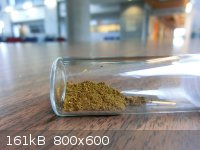
I believe that the compound I was able to synthesis based on the color, is stage one potassium graphite with the chemical formula KC8.
I would like to synthesis stage 2, which should be a nice blue color with a chemical formula of KC24. But that has a few challenges of its own.
Just wanted to share my interests and I would love to hear from other members.
On a side note my previous post said that I used 30ml of solvent in the reaction, actually when I repeated my experiment using 30ml I was not able to
get any potassium. So I reduced the amount to 20ml and have been making potassium successfully ever since.
I believe using just a little more than enough solvent to cover the reactants gives the best results.
Also I have found what I think is an easier way to make magnesium shavings for the reaction. I found this circular rasp tool at home depot and put
into my drill press. By carefully running the magnesium ingot across the turning rasp very nice magnesium fillings are produced and work great in the
synthesis.
http://www.homedepot.com/p/Vermont-American-5-8-in-Rasp-File...
|
|
|
bfesser
Resident Wikipedian
    
Posts: 2114
Registered: 29-1-2008
Member Is Offline
Mood: No Mood
|
|
I hope you're planning a write up of that intercalate synthesis. I, for one, would love to read about it. I have a book on <a
href="http://en.wikipedia.org/wiki/Intercalation_(chemistry)" target="_blank">intercalation</a> <img src="../scipics/_wiki.png" />
chemistry, but haven't been motivated to read through it yet.
[edit] Just looked it up on <a href="http://books.google.com/books?id=qrFVZwdVrVgC&printsec=frontcover#v=onepage&q&f=false"
target="_blank">Google Books</a> <img src="../scipics/_ext.png" />.
[Edited on 20.8.13 by bfesser]
|
|
|
froot
Hazard to Others
  
Posts: 347
Registered: 23-10-2003
Location: South Africa
Member Is Offline
Mood: refluxed
|
|
| Quote: | | I believe that the compound I was able to synthesis based on the color, is stage one potassium graphite with the chemical formula KC8.
|
If I had that I'd try make my own K-ion cell.
Would love to see how you produced this.
[Edited on 20-8-2013 by froot]
We salute the improvement of the human genome by honoring those who remove themselves from it.
Of necessity, this honor is generally bestowed posthumously. - www.darwinawards.com |
|
|
blogfast25
International Hazard
    
Posts: 10562
Registered: 3-2-2008
Location: Neverland
Member Is Offline
Mood: No Mood
|
|
Yep, me too.
|
|
|
Squall181
Harmless

Posts: 46
Registered: 21-2-2011
Member Is Offline
Mood: No Mood
|
|
Well this may come as a surprise but it wasn't all that intricate of a synthesis.
Here are some references that I used:
http://docs.lib.purdue.edu/cgi/viewcontent.cgi?article=1094&...
http://thesis.library.caltech.edu/5574/4/Purewal_Thesis_Ch2....
When attempting the synthesis the goal was actually to make the stage 2 compound and not the stage one, but if you read the two papers they mention
that in order to obtain the stage 2 version of the compound the reaction mixture must be periodically stirred.
At the time I didn't exactly understand why this was important but it became quite clear soon after I began the synthesis.
So what I did was take 0.08 grams of K and put it into a vial with about .6 or so grams of graphite, (sorry I don't have the exact amounts in front of
me at the time, but the amounts were just scaled from the purdue link)
Next I put the vial with the cap loosely fastened into the antechamber of my lab groups glove box (at the University) and pulled a vacuum. I then
refilled the antechamber with argon and this was repeated 3times to get any air out of the vial. I then took the vial into the glovebox and screwed
the cap on tight.
I am not a regular user of the glovebox so I did not want to do any heating of the material inside of it. So, I took the sealed vial out, which now
contained argon inside and placed it into a muffle furnace and set the temperature to 150 degrees C. I left the vial at temperature overnight.
The next day I could see that a clump of something had formed inside of the vial but the majority of the graphite had not reacted. The vial was put
back in to the glove box and the clump was separated from the rest of the graphite. Crushing the lump with a glass rod revealed the nice bronze color
that can be seen in the above picture. This powder was sealed in a new vial and taken out of the glovebox.
Hope that wasn't too boring. I was going to try this at my home lab, but my vacuum pump is dead at the moment.
I would love to hear other people's ideas on how this can be done without a glovebox.
I still have not exposed the sample to air so I do not know exactly how it reacts, but I may try that this weekend just to see how sensitive the
compound is.
|
|
|
blogfast25
International Hazard
    
Posts: 10562
Registered: 3-2-2008
Location: Neverland
Member Is Offline
Mood: No Mood
|
|
Quite interesting. This compound finds uses as?
|
|
|
elementcollector1
International Hazard
    
Posts: 2684
Registered: 28-12-2011
Location: The Known Universe
Member Is Offline
Mood: Molten
|
|
As far as Wiki tells me, it may replace Li-ion batteries in the future. I find that makes no sense, as from the same source, it shows all the
reactivity of normal K metal - why on Earth would you put it in a battery?
Elements Collected:52/87
Latest Acquired: Cl
Next in Line: Nd
|
|
|
blogfast25
International Hazard
    
Posts: 10562
Registered: 3-2-2008
Location: Neverland
Member Is Offline
Mood: No Mood
|
|
EC1:
Fair point but Li is also used in Li metal batteries: that metal reactivity isn't hard to contain.
|
|
|
Toluene
Harmless

Posts: 26
Registered: 19-5-2013
Member Is Offline
Mood: No Mood
|
|
Hi!, I haven't been here for a long, and back to the work, I thought, that might be a good idea to try to catalize with diacetone alcohol, wich may
be very simple preparated with acetone and a strong base such as KOH or NaOH, I will try and I'll give you a result!
|
|
|
sbbspartan
Hazard to Self
 
Posts: 61
Registered: 6-3-2012
Location: Minnesota, USA
Member Is Offline
Mood: DEAD (diethyl azodicarboxylate)
|
|
I just had something really interesting happen!
I've tried to do this synthesis 4 or 5 times now, and the last time I tried, I finally succeeded in making some potassium. However, it was only a
bunch of very fine particles that I was unable to coalesce. I was going to post a writeup of my results on here, but I wanted to try it once more to
see if I could get some larger balls of potassium first.
So, on this most recent attempt, I had 4.8 grams of magnesium (1/2 powdered and 1/2 turnings), 10 grams of potassium hydroxide, and about 35 ml of
highly pure paraffin oil (Tiki Torch Fuel). I also added all of the tertiary butyl alcohol - about 2ml - right away since that was how I did it the
last time I got potassium (unlike all the other times I added it a little bit at a time and never got potassium). I started the synthesis like normal,
heating it up to 200+ Celcius.
Now, I normally get quite a bit of that weird white smoke coming out of the solution as it heats up, but this time was different. There was A LOT of
it this time. After about 5 minutes on the hotplate, I started seeing a few fairly large sparks in the flask. I got a bit afraid at this point, so I
turned off the hotplate. All of a sudden, the whole bottom of the flask lit up quite brightly - but not white light like magnesium burning, more of an
orange flame. There wasn't really a flame though, sort of like something burning without oxygen. After about 5 seconds, the burning completely
stopped, and my flask and condenser were covered in black soot.
My thought was that I must have heated it up too quickly or something, and the magnesium on the bottom of the flask got too hot and started to burn.
However, it got even weirder. I let the flask cool down for a while and then looked in the bottom part that wasn't covered in soot. There were tiny
little balls of potassium floating around. I might be mistaken, and it could have been magnesium powder, but they were floating, very bright/shiny,
and I'm pretty positive they weren't there before. I dumped the contents out in my sink, and poured some water on it (I didn't really realize at the
time that there was potassium in it). When the water hit it, there were tiny little sparks everywhere. It looked exactly like when I added some water
to the potassium I got in my last synthesis.
I'm not sure what else it could have been besides potassium... But the flask was only on the hotplate for 5-10 minutes. Am I just going crazy?  It took 3-4 hours before I saw potassium last time. Maybe it was actually magnesium
that caught on fire in my flask, and it was hot enough to accelerate the process...? I'm not sure. It took 3-4 hours before I saw potassium last time. Maybe it was actually magnesium
that caught on fire in my flask, and it was hot enough to accelerate the process...? I'm not sure.
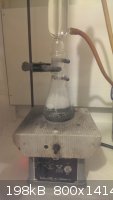 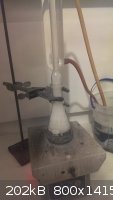 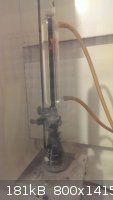
|
|
|
elementcollector1
International Hazard
    
Posts: 2684
Registered: 28-12-2011
Location: The Known Universe
Member Is Offline
Mood: Molten
|
|
Quote: Originally posted by sbbspartan  | I just had something really interesting happen!
I've tried to do this synthesis 4 or 5 times now, and the last time I tried, I finally succeeded in making some potassium. However, it was only a
bunch of very fine particles that I was unable to coalesce. I was going to post a writeup of my results on here, but I wanted to try it once more to
see if I could get some larger balls of potassium first.
So, on this most recent attempt, I had 4.8 grams of magnesium (1/2 powdered and 1/2 turnings), 10 grams of potassium hydroxide, and about 35 ml of
highly pure paraffin oil (Tiki Torch Fuel). I also added all of the tertiary butyl alcohol - about 2ml - right away since that was how I did it the
last time I got potassium (unlike all the other times I added it a little bit at a time and never got potassium). I started the synthesis like normal,
heating it up to 200+ Celcius.
Now, I normally get quite a bit of that weird white smoke coming out of the solution as it heats up, but this time was different. There was A LOT of
it this time. After about 5 minutes on the hotplate, I started seeing a few fairly large sparks in the flask. I got a bit afraid at this point, so I
turned off the hotplate. All of a sudden, the whole bottom of the flask lit up quite brightly - but not white light like magnesium burning, more of an
orange flame. There wasn't really a flame though, sort of like something burning without oxygen. After about 5 seconds, the burning completely
stopped, and my flask and condenser were covered in black soot.
My thought was that I must have heated it up too quickly or something, and the magnesium on the bottom of the flask got too hot and started to burn.
However, it got even weirder. I let the flask cool down for a while and then looked in the bottom part that wasn't covered in soot. There were tiny
little balls of potassium floating around. I might be mistaken, and it could have been magnesium powder, but they were floating, very bright/shiny,
and I'm pretty positive they weren't there before. I dumped the contents out in my sink, and poured some water on it (I didn't really realize at the
time that there was potassium in it). When the water hit it, there were tiny little sparks everywhere. It looked exactly like when I added some water
to the potassium I got in my last synthesis.
I'm not sure what else it could have been besides potassium... But the flask was only on the hotplate for 5-10 minutes. Am I just going crazy?  It took 3-4 hours before I saw potassium last time. Maybe it was actually magnesium
that caught on fire in my flask, and it was hot enough to accelerate the process...? I'm not sure. It took 3-4 hours before I saw potassium last time. Maybe it was actually magnesium
that caught on fire in my flask, and it was hot enough to accelerate the process...? I'm not sure.
|
Curious... But magnesium can also react with water at elevated temperatures - it's not out of the question.
Elements Collected:52/87
Latest Acquired: Cl
Next in Line: Nd
|
|
|
sbbspartan
Hazard to Self
 
Posts: 61
Registered: 6-3-2012
Location: Minnesota, USA
Member Is Offline
Mood: DEAD (diethyl azodicarboxylate)
|
|
Yeah, it was really weird. Thats never happened in all the times I've tried this experiment. I agree that the magnesium explains the sparks and the
fire I saw pretty well. A hot spot could have formed on the bottom of the flask and gotten hot enough to ignite the magnesium.
However, I did let the flask and its contents completely cool down to room temperature before I dumped it into the sink. I don't know how the
magnesium could have reacted with the water and produced those sparks in the sink when it was cold.
I'm not sure I could reproduce what happened, and I'm not really sure I want to anyway. I'll try the synthesis again tomorrow with slower heating and
better stirring. I have to go clean out my blackened glassware now... 
|
|
|
Pyro
International Hazard
    
Posts: 1305
Registered: 6-4-2012
Location: Gent, Belgium
Member Is Offline
Mood: No Mood
|
|
I just obtained a gallon of 2-Ethylhexyl 7-oxabicyclo(4.1.0)heptane-3-carboxylate, it's density is even greater than tetralin. Is this a good solvent?
I intend to run this reaction tomorrow, but would like some opinions on the solvent first.
and tossing in a stirbar to keep it mixed?
[Edited on 5-11-2013 by Pyro]
all above information is intellectual property of Pyro.  |
|
|
Lambda-Eyde
National Hazard
   
Posts: 857
Registered: 20-11-2008
Location: Norway
Member Is Offline
Mood: Cleaved
|
|
Quote: Originally posted by Pyro  | | I just obtained a gallon of 2-Ethylhexyl 7-oxabicyclo(4.1.0)heptane-3-carboxylate, it's density is even greater than tetralin. Is this a good solvent?
|
For making potassium? No. Not at all. And where the heck did you get that, and what is it used for? Plasticizer?
This just in: 95,5 % of the world population lives outside the USA
You should really listen to ABBAPlease drop by our IRC channel: #sciencemadness @ irc.efnet.org
|
|
|
| Pages:
1
..
56
57
58
59
60
..
66 |